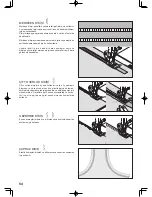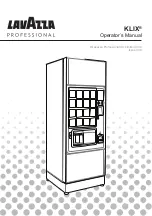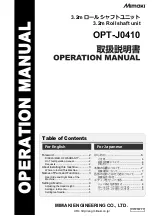
47
POINT INVISIBLE
1. D’abord surfiler les bords avec un zigzag, ensuite plier
l’ourlet sur la largeur désirée et repasser.
2. Maintenant, pliez le tissu comme montré dans l’illustration
avec le mauvais côté tourné vers le haut.
3. Placez le tissu sous le pied. Faites tourner le volant vers
vous à la main jusqu’à ce que l’aiguille aille complètement
vers la gauche. Elle ne devrait percer que le pli du tissu. Si
elle ne le fait pas, ajustez le guide (B) du pied invisible (A)
de façon à ce que l’aiguille ne perce que le pli du tissu et
que le guide repose juste sur le pli.
Effectuez la couture lentement, tout en guidant
soigneusement le tissu le long du bord du guide.
4. Lorsque l’ourlet est terminé, les points sont presque
invisibles sur l’endroit du tissu.
- Point invisible pour les tissus tissés
- Point invisible pour les tissus extensibles
RÉGLAGES :Pied presseur - Pied point invisible
:Réglage tension du fil supérieur - AUTO
REMARQUE: pour un point invisible plus étroit ou plus
large, ajustez d’abord manuellement les commandes
de la largeur et de la longueur aux largeurs et
longueurs désirées. Puis ajustez le guide du pied.
REMARQUE: la couture d’ourlets invisible demande
de la pratique. Pour commencer, effectuez toujours
une couture d’essai.
1. With matching thread finish the raw edge. On fine fabric
turn up and press a small ½” or less hem. On medium to
heavyweight fabrics overcast the fabric’s raw edge.
2. Now fold the fabric as illustrated with the wrong side up.
3. Place the fabric under the foot. Turn the handwheel
towards you by hand until the needle swings fully to the
left. It should just pierce the fold of the fabric. If it does not,
adjust the guide (B) on the Blindhem Foot (A) so that the
needle just pierces the fabric fold and the guide just rests
against the fold.
Sew slowly, guiding the fabric carefully along the edge
of the guide.
4. When completed, the stitching is almost invisible on the
right side of the fabric.
- Regular blind stitch for normal firm fabrics
- Elastic blind stitch for soft, stretchable fabrics
BLINDHEM STITCH
Settings : Presser foot - Blind stitch foot
: Thread Tension Control: AUTO
The blindhem stitch is primarily used for creating nearly
invisible hems on curtains, trousers, skirts, etc.
NOTE: It takes practice to sew blind hems. Always
make a sewing test first.
NOTE: In addition to the adjustment on the foot,
the stitch width control can be used. The stitch
width control changes the swing of the needle for a
more narrow or wider stitch.
















































